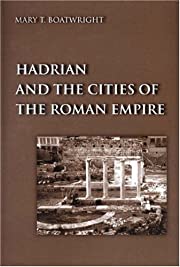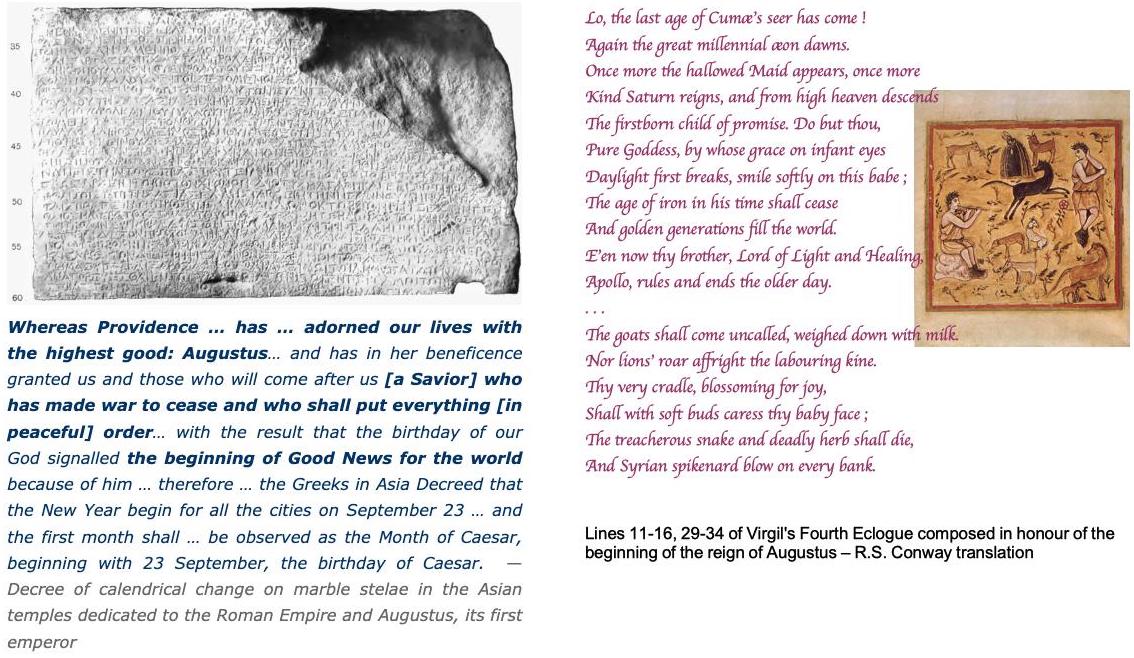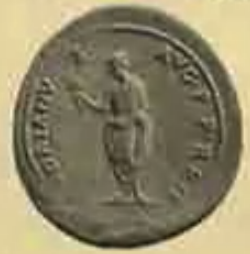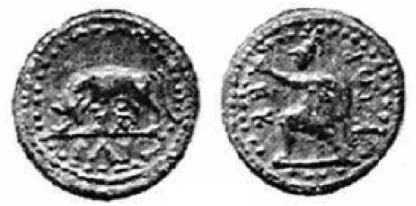In the preceding post I copied extracts from Demetrios Kritsotakis’s thesis Hadrian and the Greek East that illustrated the unprecedented level to which the Roman emperor Hadrian was exalted as a divinity — all in the context of Thomas Witulski’s thesis that the Book of Revelation is best dated to the time of Hadrian (117-138 CE). Here I continue quoting Kritsotakis (and works he cites) insofar as they arguably support the interpretation that Hadrian best represents the principal “beast” figure in Revelation.
Who can make war with the beast?
.
Hadrian followed a non-expansion policy and his reign was marked by a general lack of major military conflicts, apart from the Second Roman-Jewish War.
The peace policy was further strengthened by the erection of permanent fortifications along the empire’s borders, such as the British Wall and the fortifications along the Rhine frontier. (pp 1f)

Hadrian abandoned his predecessor Trajan’s newly conquered territories of Mesopotamia, Armenia and Assyria, an unpopular decision with many Roman senators, but he “made up” for those withdrawals by establishing secure and clearly visible boundaries and introducing an era of “peace and prosperity”:
However, Hadrian insisted on holding the Empire within its limits, on the one hand by ceasing further expansion, on the other by marking the limits of the Empire. Beginning in 121, a continuous palisade was to mark the empire’s limits on the Rhine frontier. Besides its military value, to the barbarians it marked off the Empire more clearly than ever before. In Britain he began, in 122, the great Wall and in North Africa he organized the southern frontier of the Empire. (p. 32)
After he was declared emperor in 117 . . . the strengthening of the empire’s frontiers became a priority for Hadrian. Accordingly, during his first trip from 121 to 125 Hadrian paid special attention to the borders of the empire. It was in this period that he inaugurated the construction of the British wall (122) as well as of a palisade on the Rhine frontier (121), and there is evidence that he attempted to construct a similar border in Northern Africa153. To further secure the borders of the empire, Hadrian improved military discipline by example. According to Dio, the emperor so trained and disciplined the army both by his example and his precepts that even in Dio’s own days “the methods then introduced by him (Hadrian) are the soldier’s law of campaigning.”
153 . . . A passage in [Historia Augusta] may allude to it. The author claims that “in many regions where the barbarians are [held] back not by rivers but by artificial barriers, Hadrian shut them off by means of high stakes planted deep in the ground and fastened together in the manner of a palisade” (pp. 68f.)
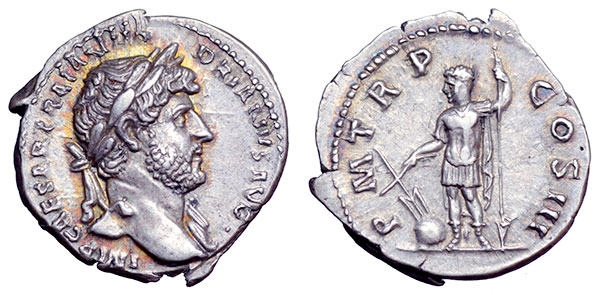
Another allusion to Hadrian’s domination of the world, this time emphasizing his military skills, is found on a silver denarius from Rome. The obverse depicts a laureate bust of Hadrian while another image of the emperor is seen on the reverse. Here the emperor is presented bare-headed, in military dress, holding a rudder on a globe in his right hand and a spear reversed in his left. The image of the emperor who seems to rest rather than being in preparation for a battle, and the symbol of leadership, the rudder, resting on the globe, speak of his rule over the world, achieved by military skill. (140)
Hadrian as a New Nero
.
Nero scandalized many conservative Roman elites with his open displays of love for the Greek world and its culture. In this respect he was matched only by Hadrian, except that Hadrian did not repeat Nero’s mistake of importing his beloved Greek ways into Rome.
The desire for a Greek political rejuvenation and cultural renaissance reached a climax under the most Philhellenic emperor, Hadrian. . . .
. . . . Roman tolerance towards the Greeks that derived from respect for the Greek past; the Philhellenic attitude of certain emperors of the first century, in particular that of Nero, with the famous grant of freedom to Achaea; the benefactions that adorned the Greek cities; and the increasing participation of local elites in imperial administration . . . . (p. 21)
We can say with confidence that Hadrian, with the exception of the years during which he remained at Rome and its vicinity (119-120, 126-127, and the final years of his reign), devoted at least half of his reign to the inspection of the provinces and in particular the eastern ones. This was in marked contrast to some of his predecessors (e.g., Augustus, Trajan) and successors (e.g. Marcus Aurelius), who traveled outside of Italy mostly for military reasons. Others remained for most of their reign in the vicinity of the capital (such as Tiberius and Antoninus Pius), while Nero’s cultural journey to Greece in 66-67 seems to be the major exception. (p. 67)
Nero is not mentioned in the following passages but the theme is most definitely a repeat of one that Nero was most famous for (infamous, in the eyes of the upper classes of Rome) and that contributed much to Nero’s popularity:
Hadrian was accessible to all classes and, as the Historia Augusta tells us, he was accustomed to the company of the humblest of men and despised any person who, under the pretext of imperial dignity, begrudged him the pleasure of such friendliness. Despite the reliability issues that the biography presents, it abounds with examples of his beneficence to the poor and invalid, which do not seem to be far from reality: to the poor he saw, he gave money of his own (XXII.9); he increased the alimenta paid to the children of the poor (VII.8); he boasted more than anyone about his love of the plebs, “fuit et plebis iactantissimus amator” (XVII.8); and he often bathed in the public baths, even with the common crowd (XVII.5). In the eyes of his subjects the emperor seems to value quality and character more than birth and rank. He was a princeps civilis, and in the meetings of the people and in the senate he often said that he would so administer the empire that people would know that it was theirs and not the princeps. The people should be at the center of the imperial program.
His contemporaries seemed to welcome his intentions and even the hostile Dio pays him a tribute. Dio goes on to say how Hadrian was accustomed to the contact with common people and was not offended by it. On one case, he says, Hadrian while on a journey passed by a woman who made a request. The emperor initially replied “I have not time”, but when she cried out “then, cease being an emperor”, he turned about and granted her a hearing. . .
Hadrian’s familiarity with common people . . . is evident even in the generally negative Jewish tradition, where Hadrian is represented as conversing with ordinary Jews and Rabbis. Thus, Hadrian (אדריינוס in the texts) is portrayed questioning Rabbi Yehoshua b. Hananya about various themes of the Jewish religion (mentioned by Schäfer on p. 236); is compared to King Solomon (p. 237); in another story, he treats kindly a little girl affected by leprosy (p. 238-239); and in one anecdote (p. 241-242), Hadrian, “may his bones rot” (as virtually every reference to him in the rabbinical literature adds), questions a centenarian peasant whom he encountered planting a fig tree. It is unknown whether these stories were fictional or not but they can be indicative of the power of perception. I believe that as Hadrian was reputed to be plebis iactantissimus amator and conversing with leading figures and common people alike, so it is reasonable to assume that the authors and the people in general would think about and judge him according to that reputation. (pp. 96ff.)
A New “Golden Age”
.
Hadrian sought a peace, which clearly paved the way for the next decisive step of his reign: that of the development and prosperity of the Empire. (p. 32)
Under Hadrian, the Athenians saw their city transformed from a relative poor city to a cultural capital of the Greek East. Hadrian filled Athens with a series of constructions that embellished the city and eased the life of its people: the construction of an aqueduct and reservoir on the lower slopes of Mt Lycabettos augmented the city’s water supply; the gift of the gymnasium contributed to the city’s cultural life 79.
Hadrian left his everlasting mark on the city with works such as the Library, the temple of Hera and Zeus Panhellenios, the Pantheon, and the transformation of the area of the temple of Zeus. In a letter of 131/2 to his favorite city, Athens, regarding the gymnasium, the emperor did not miss the opportunity to remind his addressees of his intentions: “know that I use every kind of excuse to benefit both the city in public and, in private, certain individuals.”
79 For a list of Hadrian’s utilitarian buildings and those serving religious activities and spectacles in the Empire see Boatwright (2000) 108ff. (p. 36)
It’s worth taking a break to consult that citation of Boatwright:
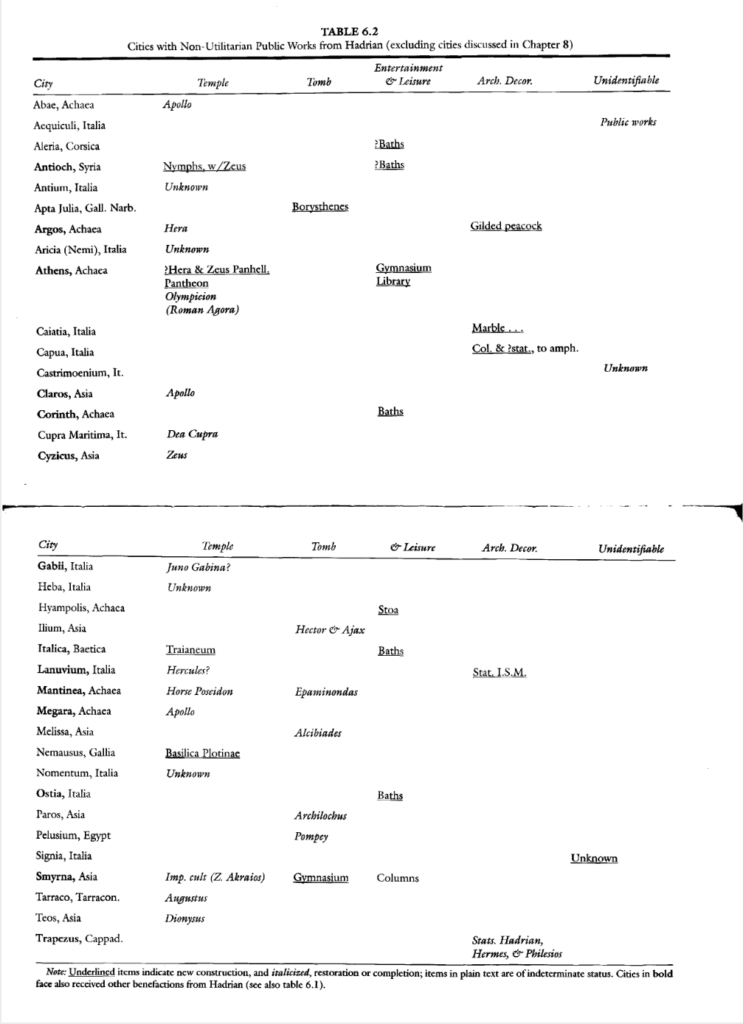 That table excludes the cities discussed in chapter 8. To get some idea of those projects here is a map from chapter 8:
That table excludes the cities discussed in chapter 8. To get some idea of those projects here is a map from chapter 8:
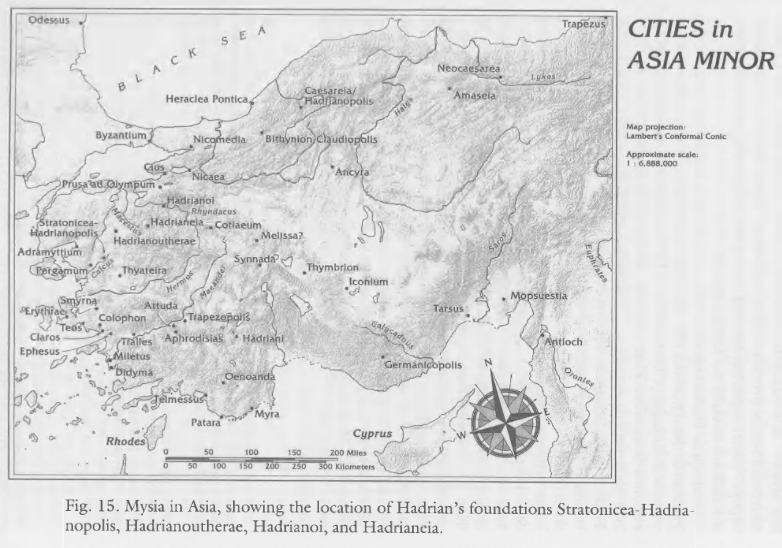
Returning to K.:
Not only Athens but the entire Greek world benefited from the presence of the emperor. During his frequent visits to the Greek East, the cities enjoyed the benefactions of the emperor in the form of financial aid, land donations, and building programs. Accordingly, for example, he granted Sparta, in 125, the island of Caudos off the coast of Crete and the port of Corone on the gulf of Messenia, both valuable sources of revenue. It is possible that he allowed the city to import corn from Egypt. A series of altars from Sparta honoring Hadrian as savior, founder, and benefactor reveal the city’s gratitude.
Frequent visits to Asia Minor led to unparalleled cultural and building activity there. All the major cities of the region attracted the interest of the emperor and local intellectuals, such as Polemon [recall Revelation’s Second Beast], struggled to gain the emperor’s favor for their own homeland. Ephesos was allowed to import grain from Egypt and received funds on a lavish scale for the temple of Artemis, while at the same time Hadrian contributed to the repairing of its ports. Smyrna received 10 million drachmae for the construction of a grain market and for a gymnasium as well as for the temple of Zeus in 124. In the same year, the city of Cyzicus was granted the role of neokoros, temple warden of the imperial cult, joining Pergamos, Ephesos, Smyrna, and Sardeis. Throughout the Empire the advent of the emperor was seen as an opportunity for transformation and renaissance. (p. 37)
According to K, Hadrian’s aim was to make the Greek world a second centre of the empire, one in the east to balance Rome in the west, and accordingly enhance the unity of the empire by enabling the Greeks to feel as much part of “Rome” as the Romans. Nero had promoted Hellenistic culture but had made the mistake of trying to make it part of Roman life. Hadrian avoided that mistake by not offending Roman sensitivities.
The emperor carefully presented his Greek program to them, a program that could lead to the elevation of the Greek East to a status of equality with Rome. Latin West and Greek East could function as the two centers of the Empire producing culture and advancing politics. Hadrian fostered his relations with the local populations, secured their loyalty, exchanged ideas, and invited them to share in and contribute to his vision for the Roman Empire, of which they must be now active members. (pp. 39f.)
.
Material benefits followed … but material benefits, as we have seen, were also a prompt to regard Hadrian as a god:
Polemon was able to win for Smyrna huge favors from the emperor: among them, ten million drachmas for the construction of a grain-market and a gymnasium, and a second neocoria. (p. 76)
.
Hadrian promoted himself as a restorer of the Rome bequeathed by his predecessor Trajan:
By issuing coins with the [phoenix] Hadrian affirms his affiliation with [Trajan]. The association of Trajan with a phoenix on coins is a way to preserve the memory of the imperium of Trajan and to show the will of Hadrian to be seen as the son of Trajan and follow in the foot-steps of his predecessor as a good emperor. (119)
The general idea, expressed by the phoenix, was known to all: Hadrian was a new Trajan. (121)
A New Augustus
But more than a new Trajan, Hadrian promoted himself as the new Augustus, the first emperor and inaugurator of the “golden age”:
The imperial coinage at about this time drastically abbreviates Hadrian’s titulature. Instead of being styled “Imperator Caesar Traianus Hadrianus Augustus”, he was soon presented simply as “Hadrianus Augustus“, a form which was not carried on the coinage of his predecessor. The message conveyed is clear enough: he wanted to be seen as a new Augustus. He wished to model himself on the first Princeps, emulate his saeculum aureum [golden age], and return to the Augustan policy of non-expansion. (121f. — the allusion here is to the simplicity of ways promoted by Augustus)
Recall that it is from the reign of Augustus that we encounter the term “good news” and the message of a golden age of peace:
.
We may default to thinking of Pluto as the god of the underworld but he was also the god of wealth. Pluto, recall, was also famed as the god who captured the daughter of Demeter (Roman Ceres), the god of grain, harvest, and plenty. The Eleusinian mystery religion commemorated this myth and Hadrian was initiated into its higher levels.
. . . the legend [on the coin] is connected with Hadrian’s initiation into the Eleusinian Mysteries. In September 128, five years after his initiation into the first grade, Hadrian took part in the mysteries again. The grain stalk held by the emperor symbolizes the connection of the Mysteries with Demeter. Hadrian received initiation at Eleusis and was reborn to the eternal life of the faithful “mystic”. The portrait of Augustus on the obverse takes on greater significance since the first princeps was the only emperor before Hadrian to have been initiated. He had likewise advertised the fact on the Asian cistophori with a reverse depicting ears of corn. Accordingly, the legend “renatus” refers not only to Hadrian’s religious rebirth at Eleusis, but more generally to his rebirth as a second Augustus. Recollection of their common religious experience symbolized the spiritual kinship of Hadrian and Augustus. (123 – K has a different interpretation of the grain:– see side box)
A New Pluto
Another scholar cited by K is Kevin Clinton who wrote in an article on Hadrian’s contribution to the renaissance of Eleusis,
A remarkable series of silver coins shows Hadrian on the reverse holding a bunch of grain stalks, with the legend: HADRIANUS AUG P P REN. D. Kienast has shown that the last word is to be expanded to read ren(atus). Although “renatus” is not attested in connection with the Eleusinian Mysteries, it probably has a special significance here for Hadrian. The god with the features of Hadrian, holding stalks of grain, is Ploutos, the youth who appears in Eleusinian scenes either with a horn of plenty or simply stalks of grain. “Renatus”, I should think, refers to the rejuvenation experienced in the Mysteries and, in Hadrian’s case, to his new life as the young god Ploutos. Ploutos, celebrated in the Mysteries, was the prosperity that comes to men from the Two Goddesses: “Very prosperous is he who of mortal men is loved by these goddesses; straightway do they send to his great home Ploutos, who sits by his hearth and brings wealth to mortals” (Hymn Hom. Dem. 486-89). On a sesterce Hadrian is represented with a crown of wheat stalks; this too is the iconography of Ploutos. And on an Eleusinian statue base a hierophantid of Demeter warmly praised the Ploutos that Hadrian bestowed on all cities, especially on the city of “famous Cecropia” . . . For her, then, he was not just Ploutos, but had taken on the divine role of Demeter and Kore as dispenser of Ploutos. (Clinton, 57f.)
A New Romulus
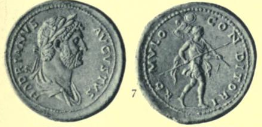
ROMVLO CONDITORI [=founder]
As second Augustus, Hadrian inherited the first princeps’ role of new Romulus. Hence the type of Romulus advancing with spear and trophy on sestertii-size medallions, a type shared with aurei and denarii. On the obverse of this type, Hadrian, laureate or bare headed, with the legend Hadrianus Augustus Cos III PP. On the reverse, as mentioned, Romulus, bare headed, advances in military dress and carries a spear in his right hand and a trophy over his shoulder in his left hand. The legend reads Romulo Conditori. The dedication to ‘Romulo Conditori” is essentially homage to Hadrian, the new founder of Rome. (125f.)

An interesting piece comes from Bithynia. The aes was issued by the Bithynian Koinon during Hadrian’s reign. The bronze depicts Hadrian’s bust on the obverse, while on the reverse an octastyle temple dominates the scene. Inside the temple the she-wolf suckles the twins. The legend reads Κοινὸν Βειθυνίας. The temple is surely an allusion to the imperial cult. The design was very common in Asia Minor and we find an interesting combination of images on a bronze from Ilion [=Troy], which was struck throughout the second century AD. . . .
. . . . The coin depicts the she-wolf suckling the twins not on the reverse, but on the obverse, while Hector, holding spear and shield, is shown on the reverse. The point is very clear: both cities share the same past, the same legends. The ties between the two cities and Ilion’s continuity in Rome are messages that were understood by everyone. Preeminence is given to Rome, as the she-wolf is selected to dominate the obverse. The “metropolis” recognizes the superiority of the daughter-city and pays homage to her. (127)
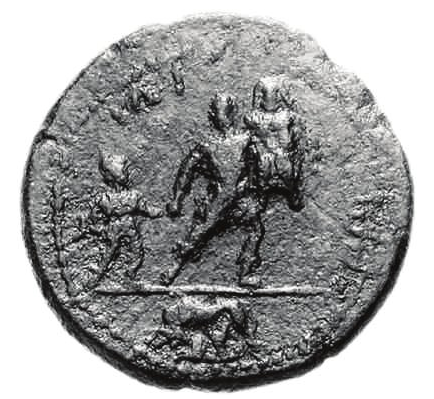
The close ties between Rome and Ilion are demonstrated again on a coin from the same city dated to Hadrian’s reign. It depicts Hadrian’s crowned bust on the obverse with the legend Αὐτ Καίσ Τρα Ἁδριανὸς. The reverse combines scenes that most explicitly demonstrate the continuity of history: Aeneas carries Anchises and holds Ascanius’s hand; next to them, the she-wolf with the twins. The legend reads Ἰλιέων. (128)
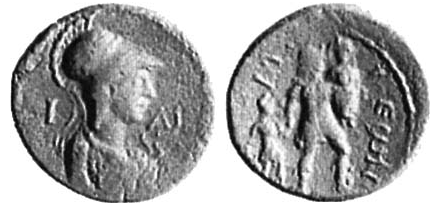
The iconography of Aeneas was popular in Rome and Asia Minor as attested by another Hadrianic from the same city that portrays the head of Athena on the obverse and Aeneas carrying his father and leading Ascanius on the reverse. The coins of Apameia, in Bithynia, from the time of Hadrian onwards, also carry the design. In this context of Hadrian’s association with Roman history and myths, we must place the coins that depict Hadrian in association with Aeneas’ and Rome’s mother, Venus Genetrix. (128)
.
We have seen his interest in mystery religions. Astrology was another special interest. Hadrian appears to have cast his own horoscopes to plan the coming years.
According to Dio, the emperor was most curious and used divinations and incantations of all kinds. He was also versed in astrology, as this is evidenced in his knowledge of Aelius Verus’ horoscope, and he reportedly gave oracles and predicted the future. . . . Hadrian’s association with superhuman, almost divine powers was part of that religious language and themes that were familiar to the Greek populations in the East, and consequently facilitated the approval of the emperor and his plans by the Greeks. (189)
And then there was the occult:
The Art of the Occult
Hadrian reportedly employed divinations and magic arts of all kinds. The inherent curiosity of the emperor for everything strange and exotic is excellently portrayed in a magical papyrus now in Paris. The text talks about a “spell of attraction” (Ἀ γωγ ή ) that attracts those who are uncontrollable, inflicts sickness excellently and kills powerfully, sends dreams beautifully, and accomplishes marvelous dream revelations (ll. 2437-2440). Then the text claims that Hadrian witnessed a demonstration by a prophet from Heliopolis called Pachrates. Pachrates revealed the power of the potion and his own art: “for he attracted within an hour, made someone sick within two hours, killed within seven hours, and even sent the emperor himself dreams, thus the emperor testing thoroughly the very truth of his magical powers. The emperor so marveled at the prophet that he ordered double allowance to be given to him (ll. 2449-2451). (190)

The historian Cassius Dio rejected Hadrian’s claim that his boy companion Antinous died accidentally by drowning and accused Hadrian of having offered him as a sacrifice in order to heal himself of an illness and prolong his life.
He justifies this allegation with the following statement: “for Hadrian in all things, as I said, was most superstitious, and used all kinds of divinations and magic arts” (. . .69.11.3). Indeed, he adds, Antinoos offered his life for Hadrian for “it was necessary that a life should be surrendered freely for the accomplishment of the ends Hadrian had in view.” It seems that Hadrian wanted to extend his own life, and when the magicians demanded a volunteer to substitute for him, Antinoos offered (or forced to) himself. (191 — In 69.22.1 Dio accuses Hadrian of uselessly turning to “charms and magic rites” for healing.)
.
It is interesting that in Dio’s History the use of charms, spells, and magic arts, is treated from a negative point of view. In his work, all three words, “μαγείαι”, “μαγγανείαι”, and “γοητείαι” are either the work of non-Romans (sometimes helping but usually resulting to endangering individuals), or the constant occupation of evil and immoral individuals, who quite often are banned from Rome. It is noteworthy that no emperor other than Hadrian is presented in his work as constantly employing such arts. (194)
Let’s conclude with a reach for the superhuman, even the divine:
At the same time [as Greeks addressed Hadrian as one of their mythical gods or heroes] rumors of his idiosyncrasies were circulating fast. The complex personality of the emperor as well as his interest in every kind of knowledge, as this is evidenced in our sources, created an almost mythical aura around him and raised him to the level of divine and superhuman. The emperor was certainly flattered by such rumors and did nothing to prove them wrong. On the contrary, during his journeys around the Mediterranean, he eagerly sought contact with the supernatural. This behavior did not seem to offend the Greek people. It was probably within the limits of behavior they could accept from a ruler. (218)
.
Boatwright, Mary Taliaferro. Hadrian and the Cities of the Roman Empire. Princeton, N.J., 2000.
Clinton, Kevin. “Hadrian’s Contribution to the Renaissance of Eleusis.” Bulletin Supplement (University of London. Institute of Classical Studies), no. 55 (1989): 56–68.
Duncan, Thomas S. “The Aeneas Legend on Coins.” The Classical Journal 44, no. 1 (1948): 15–29.
Gnecchi, Francesco. I Medaglioni Romani, Descritti Ed Illustrati Da Francesco Gnecchi. Milano U. Hoepli, 1912. http://archive.org/details/imedaglioniroman03gnecuoft.
Kritsotakis, Demetrios. Hadrian and the Greek East: Imperial Policy and Communication. PhD, Ohio State University, 2008.
Mattingly, Harold. Coins of the Roman Empire in the British Museum Vol.3 (Nerva to Hadrian). London: British Museum, 1936. http://archive.org/details/in.gov.ignca.17029.
Mayor, Joseph B. (Joseph Bickersteth), Robert Seymour Conway, and W. Warde (William Warde) Fowler. Virgil’s Messianic Eclogue, Its Meaning, Occasion, & Sources; Three Studies. London, J. Murray, 1907. http://archive.org/details/virgilsmessiani01fowlgoog.
Calendar inscription text is from
Crossan, John Dominic. Jesus: A Revolutionary Biography. San Francisco: Harper, 1994. p. 1
Neil Godfrey
Latest posts by Neil Godfrey (see all)
- Origin of the Cyrus-Messiah Myth - 2024-04-24 09:32:42 GMT+0000
- No Evidence Cyrus allowed the Jews to Return - 2024-04-22 03:59:17 GMT+0000
- Comparing Samaria and Judah/Yehud – and their religion – in Persian Times - 2024-04-20 07:15:59 GMT+0000
If you enjoyed this post, please consider donating to Vridar. Thanks!

